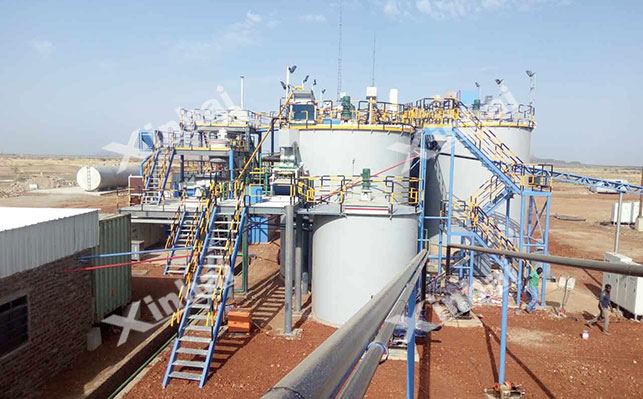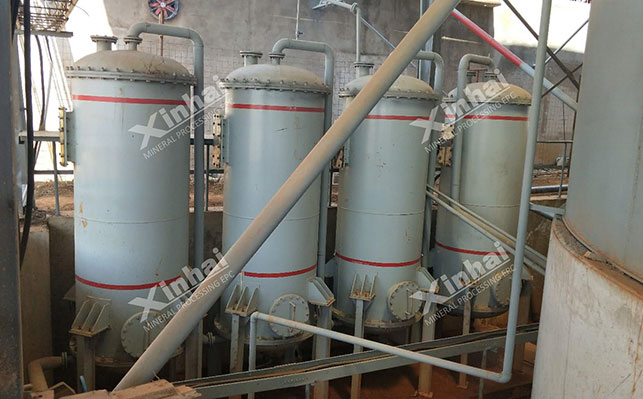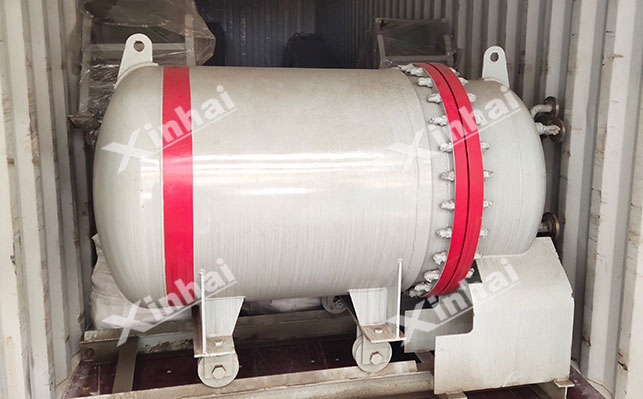
15311826613
Click to add WeChatIn the field of gold extraction from gold mines, carbon-in-pulp gold extraction technology is widely used in gold beneficiation due to its high enrichment characteristics. This technology relies on the stirring cyanidation leaching process and utilizes the adsorption characteristics of activated carbon on gold-cyanide complexes to achieve further enrichment and separation of gold from the leached precious liquid, greatly improving the utilization value of gold mine resources. This lecture will introduce the gold extraction technology of carbon-in-pulp CIP from gold mines, including CIP gold extraction, process and equipment.

Activated carbon has a large specific surface area and rich microporous structure, which can quickly adsorb gold-cyanide complexes in the solution and transfer gold from the solution to the surface of activated carbon. Through the adsorption of activated carbon, the residual gold in the solution can be recovered to the maximum extent, reducing the loss of gold and improving the utilization rate of gold mine resources. After subsequent treatment, the activated carbon adsorbed with gold can obtain high-grade gold concentrate, providing high-quality raw materials for gold refining and improving the quality and added value of gold products. At present, there are two methods for gold extraction from carbon slurry CIP: countercurrent adsorption and downstream adsorption.
The ore pulp and activated carbon flow in reverse in multiple adsorption tanks. The fresh activated carbon first contacts the ore pulp with a lower gold content after leaching. As the activated carbon moves in the adsorption tank, it gradually contacts the ore pulp with a higher gold content, thereby achieving efficient adsorption of gold.
The specific process is: the leached ore pulp is stably fed from one end of the front adsorption tank and flows through multiple adsorption tanks in series in an orderly manner. At the same time, activated carbon is added from the rear adsorption tank and moves in a completely opposite direction to the ore pulp. Inside each adsorption tank, the activated carbon and the ore pulp are fully mixed through a stirring device. In this process, the activated carbon quickly adsorbs the gold-cyanide complex in the ore pulp with its large specific surface area and rich microporous structure. After a series of continuous operations of the adsorption tanks, most of the gold in the ore pulp is adsorbed by the activated carbon. At this time, the lean liquid is discharged from the other end of the front adsorption tank, and the activated carbon full of gold is discharged from the rear adsorption tank, and smoothly enters the subsequent desorption process.
The operating mechanism of the downstream adsorption method is to keep the slurry and activated carbon flowing in the same direction in the adsorption tank. The slurry and activated carbon are fed simultaneously from one end of the front adsorption tank. During the flow, the activated carbon continuously adsorbs the gold-cyanide complex in the slurry.
The process is that the leached slurry and activated carbon enter the first adsorption tank at the same time, and are fully mixed under the strong action of the stirring device, and the activated carbon begins to adsorb gold. The mixed liquid flows through the subsequent adsorption tanks in turn, and as it flows, gold is continuously adsorbed by the activated carbon. Finally, the barren liquid and the activated carbon adsorbed with gold are discharged from the other end of the tail adsorption tank, and then the activated carbon is separated from the barren liquid by the solid-liquid separation equipment, and the activated carbon adsorbed with gold enters the desorption process.

The process flow of carbon slurry gold extraction mainly includes the preparation of leaching raw materials, addition and adsorption of activated carbon, separation of activated carbon and slurry, desorption of activated carbon, electrolytic gold extraction, and gold mud smelting.
The raw material preparation stage for gold extraction from carbon slurry is to crush and grind the mined ore to make the ore particle size reach the appropriate range. Generally, grinding to -200 mesh accounts for 60%-90% to ensure that the gold ore can fully contact with cyanide during subsequent stirring and leaching.
2. Addition and adsorption of activated carbon for CIP
Activated carbon addition and adsorption is to add activated carbon (commonly used coconut shell activated carbon) of suitable particle size to the slurry after stirring and cyaniding leaching in a certain proportion, and turn on the stirring device in the adsorption tank to promote the full mixing of activated carbon and slurry. Activated carbon quickly exerts its adsorption efficiency and quickly adsorbs the gold cyanide complex in the slurry to its own surface. The adsorption time is not fixed, but is flexibly adjusted according to the actual gold content in the slurry and the adsorption performance of activated carbon, generally within a few hours.
The separation of activated carbon from slurry is to separate activated carbon from slurry by vibrating screens, filters, etc. after the adsorption operation is completed. The vibrating screen makes the ore pulp flow on the screen through mechanical vibration. The activated carbon is effectively intercepted because its size is larger than the mesh aperture, and the lean liquid passes through the screen smoothly; the filter uses the filtering effect of the filter cloth to achieve a more refined solid-liquid separation.
Activated carbon desorption is to transport the activated carbon separated from the adsorbed gold to the desorption column for analytical treatment. The desorption methods include high-temperature and high-pressure desorption and chemical desorption. The high-temperature and high-pressure desorption method requires the introduction of a high-temperature and high-pressure alkaline cyanide solution into the desorption column. In this high-temperature environment, gold is desorbed from the surface of the activated carbon into the solution; the chemical desorption method uses specific chemical agents, such as a mixture of a high-concentration cyanide solution and a specific additive, to react chemically with the gold-cyanide complex on the surface of the activated carbon to achieve gold desorption. A gold mine has increased the gold desorption rate from 80% to 90% by optimizing the formula of the chemical desorption agent, significantly improving the gold recovery effect.
The gold-containing solution after desorption flows into the electrolytic cell. Under the action of direct current, the gold ions obtain electrons at the cathode, are reduced to metallic gold, and gradually deposit on the cathode surface to form gold mud. The electrolytic cell is usually made of stainless steel or titanium alloy, with the cathode and anode precisely set inside. The rectifier stably provides direct current to ensure that the electrolytic process is efficient and stable. During the electrolytic process, the deposition rate and purity of gold can be effectively improved by controlling parameters such as current density and solution temperature.
The gold mud obtained by electrolytic smelting is usually carried out in an electric furnace or a reverberatory furnace. The electric furnace uses electric current to generate heat through resistance to smelt the gold mud. The temperature can be as high as 1500℃ or above, which can effectively melt the gold mud and separate gold from other impurities; the reverberatory furnace heats the gold mud through the high-temperature flame and heat radiation generated by fuel combustion. Its furnace space is large and suitable for large-scale smelting operations. During the smelting process, adding flux, such as borax and sodium carbonate, can reduce the melting point of gold, improve the smelting efficiency, and finally obtain high-purity gold ingots.
As the key equipment for carbon slurry gold extraction, the adsorption tank is usually made of stainless steel or fiberglass. The high-efficiency stirring device inside can ensure that the slurry and activated carbon are fully mixed to improve the adsorption efficiency. In actual applications, some adsorption tanks are also equipped with an automatic control system, which can monitor parameters such as slurry flow and activated carbon concentration in real time, and automatically adjust the stirring speed and feed amount according to the preset values to further improve the stability and efficiency of the adsorption process.

The desorption column is made of special materials that are resistant to high pressure and corrosion, and is equipped with heating, insulation devices and solution circulation systems inside to meet the stringent process requirements of high temperature and high pressure desorption. The heating device can quickly heat the desorption solution to the set temperature, the insulation device ensures the temperature is stable during the desorption process, and the solution circulation system ensures that the desorption solution is evenly distributed in the column to improve the desorption effect. Xinhai desorption equipment can adopt intelligent control system to automatically adjust desorption temperature, pressure and solution flow rate and other parameters according to the adsorption amount of activated carbon and the desorption of gold, so as to achieve precise control of the desorption process.
The electrodeposition tank is usually a rectangular tank body made of stainless steel or titanium alloy, with cathode and anode arranged inside. The rectifier provides stable direct current to achieve gold electrolysis. In the design of the electrodeposition tank, attention is paid to the layout of the cathode and anode and the flow mode of the solution to improve the current efficiency and the uniformity of gold deposition. Some electrodeposition tanks use special cathode materials, such as titanium-coated ruthenium electrodes, which can reduce energy consumption during electrolysis and improve the deposition speed and purity of gold. In addition, the electrodeposition tank is also equipped with a liquid level control system, a temperature monitoring system, etc. to ensure that the electrolysis process is carried out under reasonable conditions.

The carbon conveying equipment mainly includes air lifts, belt conveyors, etc., which are used to realize the countercurrent transportation of activated carbon between adsorption tanks. The air lift uses the lift generated by compressed air to lift the activated carbon from one adsorption tank to another. It has the characteristics of simple structure and high conveying efficiency. The belt conveyor smoothly conveys the activated carbon through the operation of the conveyor belt. It is suitable for long-distance and large-capacity carbon conveying scenarios.
Solid-liquid separation equipment includes vibrating screens, filters, etc., which are used to separate the activated carbon and the barren liquid after gold adsorption to ensure that the activated carbon content in the barren liquid is extremely low and reduce the loss of gold. The vibrating screen can adapt to the separation requirements of activated carbon and ore pulp of different particle sizes by adjusting the vibration frequency and amplitude; the filter includes plate and frame filter presses, vacuum filters, etc. In actual applications, some gold mines use combined solid-liquid separation equipment, which is first separated by a vibrating screen and then finely filtered by a filter. The activated carbon content in the barren liquid can be reduced to a level close to zero, greatly improving the recovery rate of gold.
Smelting equipment includes electric furnaces and reverberatory furnaces. The electric furnace uses electric current to generate heat through resistance to melt gold mud. The temperature can reach above 1500℃, which can effectively melt gold mud and separate gold from other impurities. The electric furnace is suitable for production scenarios with very high requirements for gold ingot purity; the reverberatory furnace heats the gold mud through high-temperature flames and thermal radiation generated by fuel combustion. Its furnace space is large and suitable for large-scale smelting operations.
Carbon-in-Pulp technology has a high status in the field of gold extraction. In actual application, gold mining enterprises should reasonably select and optimize carbon-in-pulp gold extraction processes according to their own ore properties, production scale and market demand to achieve a win-win situation of economic benefits, environmental benefits and social benefits.